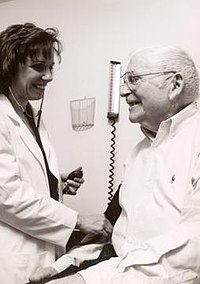
Photo from wikipedia
Objective: Globally, the proportion of people with undiagnosed and uncontrolled hypertension is significant. Typically, physician factors such as therapeutic inertia are cited or presumed to underlie a significant proportion of… Click to show full abstract
Objective: Globally, the proportion of people with undiagnosed and uncontrolled hypertension is significant. Typically, physician factors such as therapeutic inertia are cited or presumed to underlie a significant proportion of the care gap in hypertension. The objective of this study was to assess the degree to which physician versus system factors contributed to the hypertension treatment gap. Design and method: Data was obtained from the provincial medical database, the national health measures survey, as well as from quality improvement project databases. Because all persons residing in the province are covered under a single health system, it was possible to match databases within specific geographies or patient groups. Results are presented as descriptive or parametric statistics as appropriate. Results: Screening rates for hypertension in primary care for patients who visited a practice were 97%. However, screening rates for persons registered (attached) to a practice were 69%, the care gap being composed of those patients who did not visit a physician during that year. Of those patients treated for hypertension, and who regularly visited a doctor, about 80% achieved blood pressure targets. However, the overall hypertension control rate in the population was in the range of 60–65%, again with this care gap consisting of people who did not regularly see a doctor. Additionally, the greater the attachment and continuity of care with a family doctor, the lower the emergency room visit rate (r = .−64) and the also the greater the specialist availability to primary care, the lower the hospital admission rate (r = .52). When individual practices or clinics were examined via quality improvement initiatives, an identical picture was obtained: those patients who regularly attended a specific doctor/team were much more likely to be diagnosed, treated and controlled than those whose care was sporadic. Conclusions: In order to achieve better hypertension control, focusing on individual physician behavior will likely produce little benefit. Rather, ensuring patients have attachment, access and continuity of care with a doctor/team and that appropriate system (e.g. specialist) support is available for primary care is likely to result in much more benefit to a population.
Journal Title: Journal of Hypertension
Year Published: 2017
Link to full text (if available)
Share on Social Media: Sign Up to like & get
recommendations!